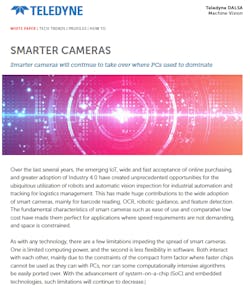White Paper: Smarter Cameras
Over the last several years, the emerging IoT, wide and fast acceptance of online purchasing, and greater adoption of Industry 4.0 have created unprecedented opportunities for the ubiquitous utilization of robots and automatic vision inspection for industrial automation and tracking for logistics management. This has made huge contributions to the wide adoption of smart cameras, mainly for barcode reading, OCR, robotic guidance, and feature detection. The fundamental characteristics of smart cameras such as ease of use and comparative low cost have made them perfect for applications where speed requirements are not demanding, and space is constrained.
As with any technology, there are a few limitations impeding the spread of smart cameras. One is limited computing power, and the second is less flexibility in software. Both interact with each other, mainly due to the constraints of the compact form factor where faster chips cannot be used as they can with PCs, nor can some computationally intensive algorithms be easily ported over. With the advancement of system-on-a-chip (SoC) and embedded technologies, such limitations will continue to decrease.
